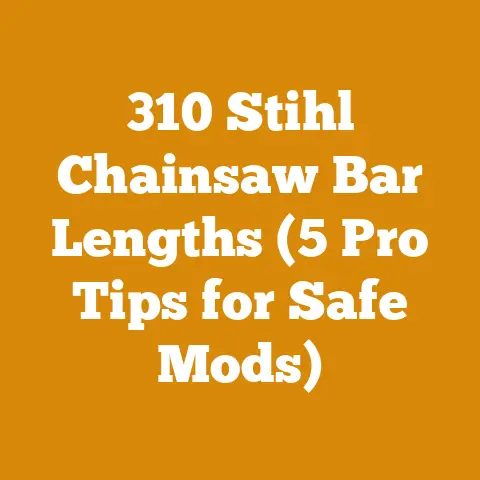Brush Bandit Wood Chipper (5 Pro Tips for Optimal Performance)
Brush Bandit Wood Chipper: 5 Pro Tips for Optimal Performance and Cost Efficiency
One of the things I appreciate most about owning a Brush Bandit wood chipper is how relatively simple it is to maintain, which translates directly to cost savings and less downtime. It’s a workhorse, designed to chew through branches and debris with impressive efficiency. However, like any piece of machinery, especially those operating in demanding environments, its performance relies heavily on proper maintenance and informed operation. So, in this article, I’m sharing five pro tips, gleaned from years of personal experience and industry best practices, to help you get the most out of your Brush Bandit wood chipper while keeping your operating costs in check.
1. Sharpen Those Blades: The Cornerstone of Efficiency and Cost Reduction
The single most important factor affecting the performance of your Brush Bandit is the sharpness of its blades. Dull blades aren’t just inefficient; they place undue stress on the engine, increase fuel consumption, and produce lower-quality chips.
Why Sharp Blades Matter:
- Reduced Fuel Consumption: Dull blades require significantly more engine power to process the same amount of material. This translates directly to higher fuel costs. I’ve personally seen fuel consumption increase by as much as 20% when blades are left unsharpened for too long.
- Lower Maintenance Costs: Overworking the engine leads to increased wear and tear, potentially resulting in premature engine failure or the need for more frequent and costly repairs.
- Improved Chip Quality: Sharp blades produce cleaner, more uniform chips, which are often more desirable for mulch or other applications. This can directly impact the market value of your processed material.
- Increased Productivity: Sharper blades mean faster processing times, allowing you to complete more work in less time, boosting your overall productivity and profitability.
Cost Implications of Dull Blades:
Let’s look at a hypothetical scenario. Imagine you’re running a Brush Bandit chipper for 40 hours a week.
- Fuel Cost Increase: Assuming an average fuel consumption of 8 gallons per hour with sharp blades and a 20% increase with dull blades, you’re looking at an extra 1.6 gallons per hour, totaling 64 gallons per week. At a fuel cost of $4 per gallon, that’s an additional $256 per week, or over $13,000 per year!
- Engine Wear and Tear: While it’s harder to quantify, the increased stress on the engine from dull blades undoubtedly shortens its lifespan and increases the likelihood of repairs. An engine overhaul can easily cost upwards of $5,000.
Sharpening Best Practices:
- Frequency: Sharpen blades regularly, ideally every 4-8 hours of operation, depending on the type of wood being processed. Hardwoods like oak will dull blades faster than softwoods like pine.
- Technique: Use a grinder specifically designed for chipper blades to ensure proper angles and balance. Maintaining the correct bevel is crucial for optimal cutting performance.
- Professional Sharpening: Consider outsourcing blade sharpening to a professional service. They have the expertise and equipment to achieve a precise and consistent edge, which can extend blade life and improve overall performance. The cost for professional sharpening typically ranges from $15 to $30 per blade, depending on the size and type of blade.
Personal Anecdote:
I remember one particularly busy season when I neglected blade sharpening for longer than I should have. I noticed the chipper was struggling to process even smaller branches, and fuel consumption was through the roof. After finally sharpening the blades, the difference was night and day. The chipper ran smoother, faster, and used significantly less fuel. It was a stark reminder of the importance of this seemingly simple task.
2. Master the Feed System: Optimizing Infeed for Efficiency and Safety
The feed system of your Brush Bandit is designed to efficiently and safely pull material into the chipper. Understanding how to properly utilize this system is critical for maximizing productivity and minimizing the risk of jams or other operational issues.
Understanding Your Feed System:
Brush Bandit chippers typically employ a combination of feed rollers and a feed table. The rollers grip the material and pull it towards the chipper knives, while the feed table provides support and guidance.
Optimizing Infeed Techniques:
- Proper Material Placement: Position material on the feed table so that it is fed straight into the rollers. Avoid feeding material at an angle, as this can cause jams and uneven chipping.
- Varying Feed Speed: Adjust the feed speed based on the type and size of material being processed. Smaller, softer materials can be fed at a faster rate, while larger, harder materials require a slower, more controlled feed.
- Avoid Overfeeding: Don’t overload the feed system. Attempting to feed too much material at once can cause jams, stall the engine, and potentially damage the chipper.
- Handle Crooked or Forked Branches Carefully: These types of branches can be particularly challenging to feed. Position them carefully on the feed table and use caution to avoid jams. I often find it useful to trim these branches before feeding them into the chipper.
- Pay Attention to Material Size: Be aware of the maximum material diameter that your chipper is designed to handle. Attempting to chip material that is too large can damage the machine.
Cost Implications of Improper Feeding:
- Increased Downtime: Jams and stalls caused by improper feeding can lead to significant downtime, costing you valuable time and money. A major jam can easily take an hour or more to clear.
- Increased Maintenance Costs: Overloading the feed system can put undue stress on the rollers, bearings, and other components, leading to premature wear and tear. Replacing these parts can be costly. Replacing feed rollers, for example, can cost anywhere from $500 to $1,500.
- Reduced Productivity: Inefficient feeding techniques slow down the overall chipping process, reducing your productivity and profitability.
Safety Considerations:
- Never Reach into the Feed System: Always use a push stick or other tool to guide material into the rollers. Never reach into the feed system while the chipper is running.
- Wear Appropriate Safety Gear: Always wear safety glasses, hearing protection, and gloves when operating a wood chipper.
Data Point:
According to a study by the Tree Care Industry Association (TCIA), improper feeding techniques are a leading cause of wood chipper accidents and injuries. By following proper feeding procedures, you can significantly reduce the risk of accidents and injuries.
Personal Anecdote:
I once witnessed a colleague attempt to feed a large, crooked branch into a chipper without properly positioning it. The branch jammed, and the force of the rollers caused it to kick back violently, narrowly missing him. It was a scary reminder of the importance of following proper feeding procedures and respecting the power of these machines.
3. Grease is Your Friend: Lubrication for Longevity
Proper lubrication is essential for extending the lifespan of your Brush Bandit wood chipper and preventing costly repairs. Neglecting lubrication can lead to excessive wear and tear on critical components, resulting in premature failure and expensive downtime.
Why Lubrication Matters:
- Reduces Friction: Lubrication reduces friction between moving parts, minimizing wear and tear and extending the life of bearings, rollers, and other components.
- Dissipates Heat: Lubrication helps to dissipate heat generated by friction, preventing overheating and potential damage to critical parts.
- Protects Against Corrosion: Lubrication forms a protective barrier against moisture and other contaminants, preventing corrosion and rust.
Lubrication Best Practices:
- Follow the Manufacturer’s Recommendations: Consult your Brush Bandit owner’s manual for specific lubrication recommendations, including the type of grease to use and the frequency of lubrication.
- Grease All Grease Fittings Regularly: Identify all grease fittings on your chipper and lubricate them regularly, typically every 8-10 hours of operation.
- Use the Correct Type of Grease: Use a high-quality, multi-purpose grease that is specifically designed for heavy-duty applications.
- Don’t Over-Grease: Over-greasing can attract dirt and debris, which can actually accelerate wear and tear. Apply grease until you see it begin to ooze out of the fitting.
- Inspect Lubrication Points Regularly: Check for any signs of leaks or damage to lubrication fittings and repair or replace them as needed.
- Consider Automatic Lubrication Systems: For high-volume operations, consider installing an automatic lubrication system. These systems automatically dispense grease at regular intervals, ensuring consistent lubrication and reducing the risk of neglect. While the initial investment might be higher (ranging from $500 to $2,000), the long-term benefits in terms of reduced maintenance costs and extended equipment life can be significant.
Cost Implications of Neglecting Lubrication:
- Premature Bearing Failure: Bearings are particularly susceptible to damage from inadequate lubrication. Replacing bearings can be a costly and time-consuming repair. A single bearing replacement can cost between $100 and $500, depending on the size and type of bearing.
- Roller Damage: Lack of lubrication can cause rollers to seize up or wear unevenly, leading to reduced performance and potential damage to the feed system.
- Increased Downtime: Equipment failure due to inadequate lubrication can lead to significant downtime, costing you valuable time and money.
Data Point:
According to a study by the Society of Tribologists and Lubrication Engineers (STLE), proper lubrication can extend the life of machinery by as much as 40%.
Personal Anecdote:
I once worked with a logging crew that consistently neglected lubrication on their equipment. As a result, they experienced frequent breakdowns and costly repairs. After implementing a strict lubrication schedule and training the crew on proper lubrication techniques, they saw a dramatic reduction in downtime and maintenance costs. It was a clear demonstration of the importance of proper lubrication.
4. Engine Health is Wealth: Scheduled Maintenance and Inspections
The engine is the heart of your Brush Bandit wood chipper, and its health directly impacts the overall performance and reliability of the machine. Regular maintenance and inspections are crucial for preventing costly engine problems and extending its lifespan.
Essential Engine Maintenance Tasks:
- Oil Changes: Change the engine oil and filter according to the manufacturer’s recommendations. Dirty oil can cause excessive wear and tear on engine components. The frequency of oil changes depends on the engine type and operating conditions, but typically ranges from 100 to 250 hours of operation. The cost of an oil change, including the oil and filter, is generally between $50 and $150.
- Air Filter Maintenance: Clean or replace the air filter regularly. A dirty air filter restricts airflow to the engine, reducing power and fuel efficiency. Air filters are relatively inexpensive, typically costing between $10 and $50.
- Fuel Filter Maintenance: Replace the fuel filter periodically. A clogged fuel filter can starve the engine of fuel, causing it to run poorly or stall. Fuel filters usually cost between $15 and $40.
- Coolant System Maintenance: Check the coolant level regularly and flush and refill the coolant system according to the manufacturer’s recommendations. Proper coolant maintenance prevents overheating and corrosion.
- Spark Plug Maintenance: Inspect and replace spark plugs as needed. Worn spark plugs can cause misfires and reduce engine performance. Spark plugs typically cost between $5 and $20 each.
- Belt Inspection and Replacement: Inspect belts for wear and tear and replace them as needed. Worn belts can slip or break, causing the engine to lose power or shut down. Belt replacement costs vary depending on the size and type of belt, but generally range from $20 to $100.
Scheduled Inspections:
- Daily Inspections: Before each use, inspect the engine for any signs of leaks, damage, or loose connections.
- Weekly Inspections: Check the engine oil level, coolant level, and air filter condition.
- Monthly Inspections: Inspect belts, hoses, and spark plugs.
Cost Implications of Neglecting Engine Maintenance:
- Reduced Engine Lifespan: Neglecting engine maintenance can significantly shorten its lifespan, leading to premature engine failure. As mentioned earlier, an engine overhaul can easily cost upwards of $5,000.
- Increased Fuel Consumption: A poorly maintained engine will typically consume more fuel than a well-maintained engine.
- Increased Downtime: Engine problems are a leading cause of downtime for wood chippers.
- Costly Repairs: Minor engine problems can quickly escalate into major repairs if left unaddressed.
Data Point:
According to a study by the American Society of Agricultural and Biological Engineers (ASABE), regularly scheduled maintenance can reduce engine repair costs by as much as 25%.
Personal Anecdote:
I had a friend who consistently ignored engine maintenance on his wood chipper. One day, the engine completely seized up, requiring a costly overhaul. He learned the hard way that a little bit of preventative maintenance can save a lot of money in the long run.
5. Know Your Wood: Understanding Wood Properties and Their Impact on Chipping
Not all wood is created equal, and understanding the properties of different wood species is crucial for optimizing your chipping operations and minimizing wear and tear on your Brush Bandit.
Key Wood Properties to Consider:
- Hardness: Hardwoods like oak and maple are denser and more difficult to chip than softwoods like pine and cedar. Chipping hardwoods requires more power and can dull blades faster.
- Moisture Content: Wet wood is more difficult to chip than dry wood. The higher the moisture content, the more power is required to process the material. Wet wood also tends to clog the chipper more easily.
- Resin Content: Some wood species, such as pine, contain high levels of resin. Resin can build up on the chipper blades and other components, reducing performance and increasing maintenance.
- Knot Size and Frequency: Wood with large or frequent knots is more difficult to chip and can put extra stress on the chipper blades and engine.
- Presence of Foreign Objects: Be aware of the potential for foreign objects, such as nails, wire, or rocks, to be embedded in the wood. These objects can severely damage the chipper blades and other components.
Impact on Chipping Operations:
- Blade Sharpening Frequency: Hardwoods and wood with high resin content will require more frequent blade sharpening.
- Feed Speed: Adjust the feed speed based on the type of wood being processed. Hardwoods and wet wood require a slower feed speed.
- Chipper Settings: Some chippers have adjustable settings for different types of wood. Consult your owner’s manual for specific recommendations.
- Maintenance: Regularly clean the chipper to remove resin buildup and other debris.
- Safety: Be extra cautious when chipping wood with knots or foreign objects.
Cost Implications of Ignoring Wood Properties:
- Increased Blade Wear: Chipping hardwoods and wood with high resin content can significantly increase blade wear, leading to more frequent sharpening and replacement.
- Increased Fuel Consumption: Chipping wet wood requires more power, resulting in higher fuel consumption.
- Increased Maintenance Costs: Chipping wood with knots or foreign objects can damage the chipper blades and other components, leading to costly repairs.
Data Point:
A study by the Forest Products Laboratory found that the energy required to chip hardwoods can be up to 50% higher than the energy required to chip softwoods.
Personal Anecdote:
I once tried to chip a pile of wet, knotty oak without adjusting the chipper settings. The blades dulled quickly, the chipper clogged repeatedly, and fuel consumption was through the roof. It was a frustrating and expensive experience that taught me the importance of understanding wood properties and adjusting my chipping techniques accordingly.
Cost Optimization: Budgeting for Brush Bandit Wood Chipper Operation
Operating a Brush Bandit wood chipper involves various costs, including fuel, blade maintenance, general repairs, and labor. By understanding these costs and implementing effective budgeting strategies, you can optimize your profitability.
Cost Breakdown:
- Fuel Costs: As discussed earlier, fuel consumption is a significant expense. Keep accurate records of fuel usage and explore ways to improve fuel efficiency, such as regular engine maintenance and proper blade sharpening.
- Blade Maintenance Costs: Blade sharpening and replacement are ongoing expenses. Track blade sharpening frequency and costs and consider using higher-quality blades that last longer.
- General Repair Costs: Set aside a budget for general repairs and maintenance. Regularly inspect your chipper and address any minor problems before they escalate into major repairs.
- Labor Costs: If you employ operators, factor in their wages and benefits. Consider training operators on proper operating and maintenance procedures to improve efficiency and reduce downtime.
- Insurance Costs: Ensure you have adequate insurance coverage for your chipper.
- Depreciation: Account for the depreciation of your chipper over time.
Budgeting Strategies:
- Track Expenses: Keep detailed records of all expenses related to your chipper operation.
- Set Realistic Budgets: Based on your historical data, set realistic budgets for each cost category.
- Monitor Performance: Regularly monitor your performance against your budget and identify any areas where you can improve efficiency or reduce costs.
- Consider Leasing vs. Buying: Evaluate the pros and cons of leasing versus buying a wood chipper. Leasing may be a good option if you have limited capital or if you only need the chipper for a short period of time.
- Explore Financing Options: If you decide to purchase a chipper, explore financing options to spread out the cost over time.
Data Point:
According to industry averages, the annual operating cost of a wood chipper can range from 15% to 25% of its purchase price.
Personal Anecdote:
I’ve found that using a spreadsheet to track all my chipper-related expenses is incredibly helpful for budgeting and cost management. By tracking my expenses, I can identify trends, spot potential problems early, and make informed decisions about how to optimize my operation.
Conclusion: Mastering Your Brush Bandit for Profitability
Owning and operating a Brush Bandit wood chipper can be a rewarding and profitable venture. By following these five pro tips – sharpening blades, mastering the feed system, prioritizing lubrication, maintaining the engine, and understanding wood properties – you can optimize the performance of your chipper, reduce your operating costs, and extend its lifespan. Remember, a well-maintained and properly operated chipper is not just a machine; it’s an investment in your business’s success. So, go out there, put these tips into practice, and watch your productivity and profitability soar! It’s all about working smarter, not harder, and that’s a principle that pays dividends in the long run.






